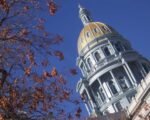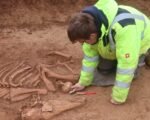As Colorado braces for what forecasters are calling a “normal” wildfire season, the Grand Junction Fire Department (GJFD) is treating that forecast with a dose of caution—and an arsenal of preparation strategies that stretch far beyond city limits.
From cross-agency alliances to local mitigation efforts and public education, GJFD is adopting an all-hands-on-deck approach to ensure the region is ready when fire season hits its stride.
No Borders, No Hesitation
“We don’t operate with borders,” said Dirk Clingman, Community Outreach Specialist for GJFD. “If there’s a large incident in the Lower Valley Fire District’s area, we go. If someone in Clifton needs help, we’re there. And if we need help, they come to us. That kind of mutual response is essential.”
GJFD has built and reinforced relationships with public safety agencies across the Grand Valley and beyond. These collaborations are central to the department’s wildfire season strategy, especially as climate patterns shift and fire behavior becomes less predictable.
“Developing partnerships and the ability to collaborate when a large fire event occurs is very important,” Clingman emphasized.

Behind the Lines: Preparing Before the Smoke
Though the calendar still shows spring, preparations for wildfire season began months ago.
The department has been coordinating with state-level fire agencies, sharpening inter-agency communication protocols, and ensuring that equipment, personnel, and emergency plans are ready for rapid deployment.
But it’s not just about what happens during a fire—it’s what happens before one ignites.
“We’re doing wildfire mitigation with local nonprofits to reduce fuels around vulnerable areas,” Clingman said. “That includes brush removal, vegetation thinning, and other landscape treatments that limit the fire’s ability to grow and spread.”
Educating the Public: From Awareness to Action
Another key pillar in GJFD’s strategy is community education. The department has ramped up its outreach to residents, pushing for more personal responsibility when it comes to wildfire prevention.
“One of the key components of wildland fire mitigation is education,” Clingman said. “We work with our community to share how to make your home what we call a defensible space.”
A defensible space refers to the buffer between a building and the surrounding wildland area, which can be the difference between minor damage and total destruction. Creating that space includes:
-
Clearing brush and dead vegetation within 30 feet of structures
-
Removing flammable objects (like wooden furniture or propane tanks) near exterior walls
-
Trimming tree branches at least 10 feet from rooftops
-
Creating a “go bag” with essentials in case of evacuation
These simple but effective steps can drastically increase a home’s survivability during a wildfire, according to GJFD.
Wildfire Outlook: “Normal” Doesn’t Mean Safe
While statewide forecasts suggest a more “average” wildfire season in 2025, GJFD isn’t taking it lightly.
“We don’t base our preparations on the word ‘normal,’” Clingman said. “Fires are going to happen. The only variable is where and when.”
Indeed, Western Colorado’s geography and vegetation make it vulnerable to fast-moving grassfires and brushfires, especially in dry, wind-driven conditions. And with many homes in the wildland-urban interface (WUI), even small fires can threaten property and lives within minutes.
Here’s how GJFD’s 2025 wildfire readiness compares to last year:
| Category | 2024 Readiness | 2025 Preparedness Initiatives |
|---|---|---|
| Interagency Collaboration | Regional mutual aid only | Expanded to include state-level partners |
| Wildfire Mitigation Projects | Limited to city-managed land | Broader partnerships with nonprofits |
| Public Education Campaigns | 4 community workshops | 12 scheduled, plus online series |
| Equipment Checks | Monthly | Biweekly leading into peak season |
| Staff Training | Seasonal brush fire drills | Full interagency wildfire simulations |
Real-Time Response, Long-Term Vision
GJFD’s wildfire response isn’t just tactical—it’s also philosophical. By treating fire preparation as a year-round, collaborative mission rather than a seasonal scramble, the department hopes to change the culture of fire awareness in Mesa County.
“We’ve seen how devastating fires can be, even in what people call a ‘quiet’ year,” said Clingman. “The goal is not just to respond quickly, but to make sure the community is better equipped to handle fire risks proactively.”
It’s a mindset that echoes across agencies and municipalities in Western Colorado—one where readiness is built through connection, shared knowledge, and an unwavering sense of duty.
Grand Valley’s Unified Front
From Grand Junction to Palisade to Fruita, the Grand Valley is forging a collective shield against fire danger. The region’s fire departments operate under a mutual aid agreement that ensures equipment and manpower flow freely when needed.
That unified response model—one without jurisdictional red tape—has proven its value in past seasons. And for Clingman, it’s a model worth reinforcing every year.
“There’s no such thing as too much preparation,” he said. “Whether it’s fire on the hillside or just the threat of one, we treat every call, every alert, every dry day seriously.”













